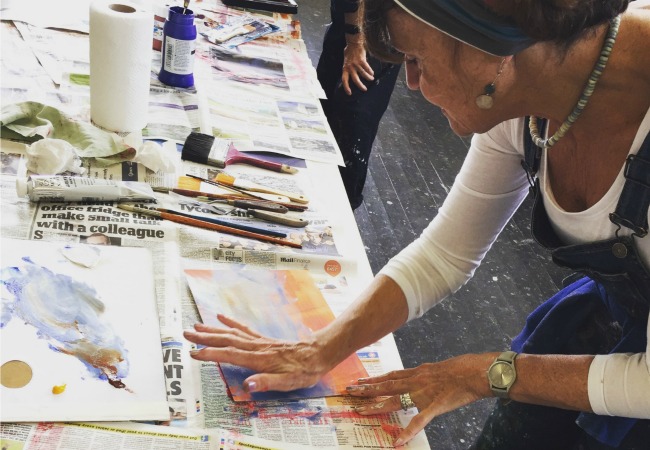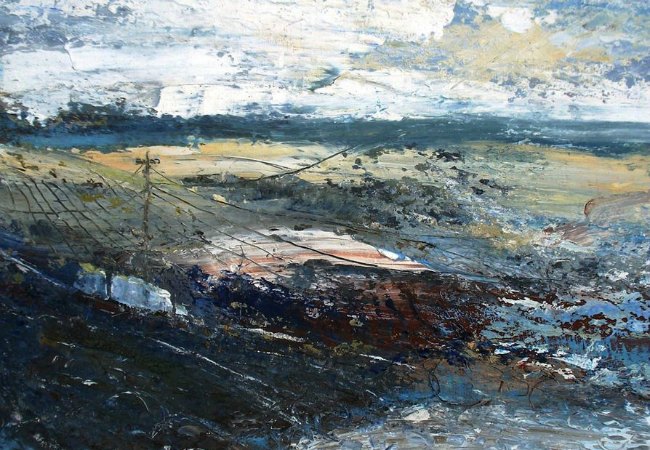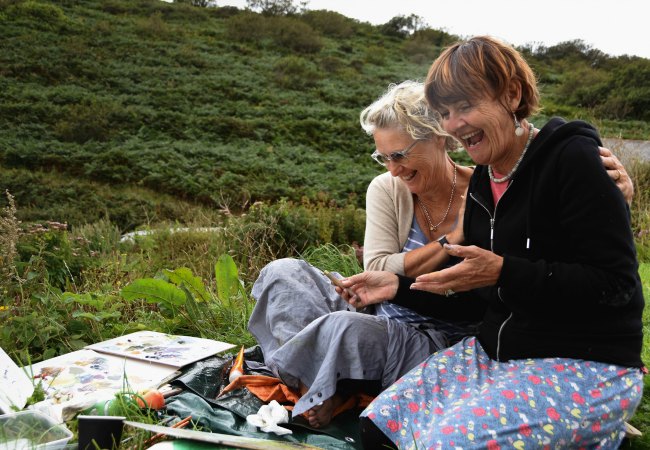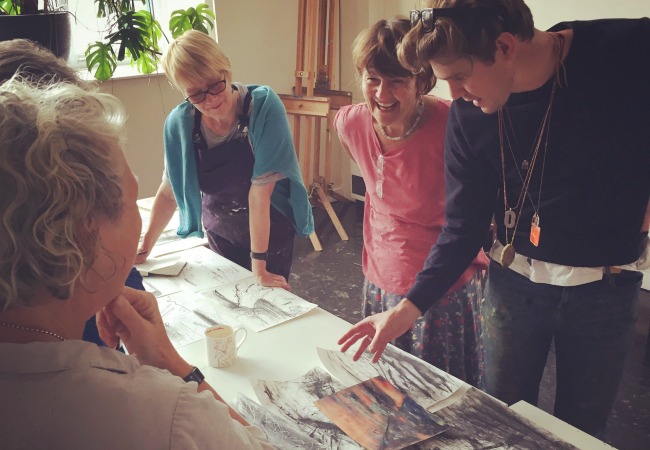A four-day landscape painting course.
Artist Maggie O’Brien has been tutoring courses at the Newlyn School of Art since it was founded in 2011. Her teaching style is inspiring and playful, based around encouraging exploration, freedom and fun. She is a master at imparting and sharing her knowledge of materials and processes whilst making everything seem possible to students with a wide range of previous experience. Kari Herbert joins Maggie and seven enthusiastic individuals on her four-day Cornish Landscapes course:
“The first thing we all need to do is let go of the feeling that we need to achieve,” Maggie O’Brien reassures us as we settle around the large wooden table, mugs of tea and coffee in hand.
There are eight of us on the course, with varying degrees of experience: there are practicing artists wanting to try new techniques, through to dedicated hobbyists and a couple (including me) who haven’t picked up a pencil or brush for over a decade. We will primarily be painting in alkyd’s (fast-drying oil paints). It is the first time many of us have used the medium, and I think I can speak for all of us when I say that, we are feeling excited and daunted in equal measure at the prospect of trying to create something half decent in the next few days.
“Trying something new, whether it’s using new techniques or materials, approaching a subject in a different way, or opening up creatively for the first time in a while can be really frightening, but we are going to play!” Maggie smiles: “If you can get into a playful mindset then you are halfway there. So don’t listen to that critical crow on your shoulder – this is a judgement-free zone!”
First we prepare boards for our first painting excursion: we prime mount boards with gesso and then apply an acrylic wash. Throughout history, many artists have worked with coloured papers, canvas and board, to provide different atmospheric or tonal qualities to a painting; notably J. M. W. Turner.
Our palette will be limited to just a few colours: ultramarine blue, cadmium yellow, burnt sienna, and white. “It’s hard enough tackling composition and tone,” Maggie continues, “add in colour and it can be a bit bewildering. Even with just these four colours you can create some beautiful effects.”
Taking a dark brown-purple pre-prepared board, Maggie mixes paint with her fingers on the palette and deftly smudges it over the surface of the board with the palm of her hand. “I can see you all looking on with horror!” she laughs. “Using your hands is not compulsory – there are brushes and palette knives for those of you who don’t like to get messy!”
With just a few strokes an atmospheric landscape painting begins to appear. She uses no photograph or sketch as a reference for this demonstration, just intuition and memory; experience informs her movements and mark-making. “After a while of spending time in nature and really looking, you begin to build up a visual dictionary,” she explains.
“For me, capturing the essence of a place and your response to it is the most important thing. No matter how good an artist you are, you cannot completely capture nature in art, you can only attempt to represent your own viewpoint. What I really want you to do is ignore that part of you that might want to illustrate what’s in front of you, and instead paint your experience of the place.”
Our first day is spent at Priests Cove, Cape Cornwall: a dramatic spot favoured by many local artists for its rocky beach and tidal pool, fishing boats, old huts and plunging cliffs. With boxes of art materials stashed at our ‘base camp’ on a nearby grassy hillock, we spread out and sketch using graphite and watercolour pencils, calligraphy pens, charcoal and chalk. Sketching is vital, we are told, to stretch our creative muscles and to work out on paper the best composition before committing to paint.
After a picnic lunch we get to grips with using alkyds. Maggie is always nearby, offering a guiding hand and spending time with each one of us individually, encouraging us to experiment with different tools and free-up our mark-marking. One of the group is plunging her paper in a rock pool, another uses dry grass to draw fine lines in paint; for others it’s enough of a challenge to use broad brushes. “I’m having so much fun!” laughs Jill, a retired nurse and watercolourist, as she enthusiastically sweeps a palette knife over her board: “You can’t do this with watercolours!” Maggie beams: “I do believe the girl has got it!”
Discussing the day back at the art school.
By day four we have visited a remarkable range of stunning coastal sites and our ‘critical crows’ have flown; we have all become more familiar with using alkyds, and more expressive (and brave) with our approach to drawing and painting. Rather wonderfully, each of us has created very individual pieces of work – some abstract, some more figurative – proving that this is not a ‘paint by numbers’ sort of course. Whether we have a painting worthy of being hung over a mantelpiece or not doesn’t matter: we have absorbed some spectacular locations, we’ve laughed and found a new creative language, and you can’t get much better than that.